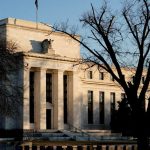
WASHINGTON/NEW YORK (Reuters) -A week of disappointing U.S. economic data, including stronger-than-expected inflation and weakening spending, has Federal Reserve policymakers doubling down on their wait-and-see approach to interest rate cuts this year, but not discouraged.
The latest bit of bad news came early on Friday in the form of a 0.5% month-on-month surge in January’s producer price index excluding food and energy, potentially undoing some of what policymakers have called “remarkable” progress on inflation.
That followed on reports earlier this week showing that consumer prices rose more than expected last month, even as a big drop in retail sales and a slide in factory production amid severe cold in some parts of the country raised questions about economic momentum.
Fed policymakers speaking on Friday took it all in stride, seeing continued if “bumpy” progress toward the Fed’s 2% goal and continued, if cooling, labor market strength that leaves the economy on track to a soft landing.
“It has not shaken my confidence we are going the right direction,” San Francisco Federal Reserve Bank President Mary Daly told a roomful of economists in Washington on Friday, of the run of recent data. “It’s about how quickly are we going to go there.”
Daly said that while there’s still “work to do” on inflation – a phrase policymakers lately have used to signal a longer hold at current rates, rather than any further rate increases – she continues to see three quarter-point cuts to the Fed’s policy rate this year as a “reasonable” path forward.
The Fed has held the policy rate in the 5.25%-5.5% range since last July.
“We will need to resist the temptation to act quickly when patience is needed and be prepared to respond agilely as the economy evolves,” Daly said.
Speaking to CNBC, Atlanta Federal Reserve Bank President Raphael Bostic appeared to be consulting the same playbook.
“We just have to be patient and let’s not get too far ahead and assume that the job is done, because there’s still work to do,” he said, noting that he expects to start rate cuts this summer, with two moves his baseline for this year, but potentially more if the data justifies it.
EXPECTATION SHIFT
Financial markets, which began the year pricing in as many as six Fed rate cuts this year, have moved closer to the view of Fed policymakers, most of whom as of December penciled in 50 to 75 basis points of rate cuts by the end of 2024.
In just the past week, futures contracts tied to the short-term policy rate abandoned bets on a May start to rate cuts, and now see June as more likely, with the policy rate seen ending the year in the 4.25%-4.5% range.
Both Daly and Bostic noted that the rapid decline in inflation last year – from 5.5% in January to 2.6% in December by the Fed’s targeted measure of the personal consumption expenditures price index – has happily taken place with only a small rise in the unemployment rate, to 3.7% last month.
The combination, Daly said, is “unequivocally good news,” but both she and Bostic said it is unclear whether that will continue, and are on the lookout for more data.
Fed Chair Jerome Powell has said the central bank needs greater confidence in inflation’s downward trajectory before it can cut rates. The latest data suggests more time may be needed.
Analysts at Citi calculated that based on the latest reading of the producer price index, the core PCE measure of inflation likely re-accelerated in January to 2.4% on a six-month basis, from a previous 1.9%.
To read the full article, Click Here

